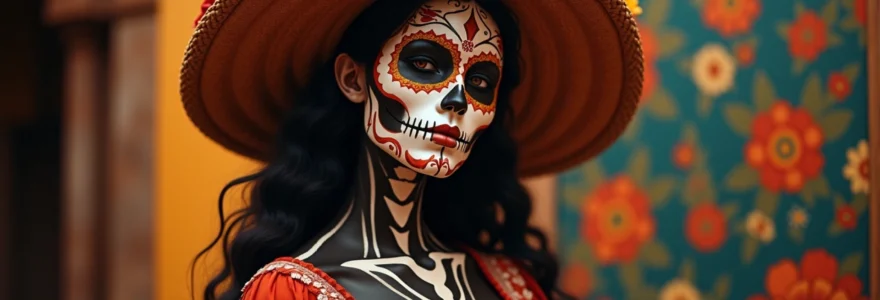Día de los Muertos, or the Day of the Dead, is a vibrant and poignant celebration that captures the essence of Mexican culture. This unique holiday blends ancient Mesoamerican traditions with Catholic influences, creating a rich tapestry of rituals and symbols that honour the deceased. Far from being a sombre occasion, the Day of the Dead is a joyous affirmation of life and a testament to the enduring bonds between the living and the departed.
As you delve into the world of Día de los Muertos, you’ll discover a fascinating interplay of history, art, and spirituality. From the colourful ofrendas (altars) adorned with marigolds and sugar skulls to the lively street parades filled with calavera (skull) face paint, every aspect of this celebration speaks to the Mexican approach to death—not as an end, but as a continuation of life’s journey.
Origins and evolution of día de los muertos in Pre-Columbian mesoamerica
The roots of Día de los Muertos stretch deep into the pre-Columbian era, where indigenous cultures across Mesoamerica held complex beliefs about death and the afterlife. For civilisations such as the Aztecs, Mayans, and Toltecs, death was viewed as an integral part of life’s cycle, not a final endpoint. These ancient peoples dedicated entire months to honouring their ancestors and departed loved ones.
In Aztec culture, the festival that would eventually evolve into the Day of the Dead was originally celebrated during the ninth month of the Aztec calendar, roughly corresponding to August. This month-long celebration was presided over by Mictecacihuatl, the ‘Lady of the Dead’, who played a crucial role in guiding the souls of the deceased through the underworld.
As centuries passed, these pre-Columbian traditions underwent significant transformations. The arrival of Spanish conquistadors and Catholic missionaries in the 16th century led to a complex process of cultural syncretism. Indigenous practices blended with Catholic observances, particularly All Saints’ Day and All Souls’ Day, which fall on November 1st and 2nd respectively. This fusion gave birth to the modern Día de los Muertos, a holiday that beautifully exemplifies the resilience and adaptability of Mexican culture.
Iconic symbols and traditions of the day of the dead
The Day of the Dead is replete with rich symbolism and time-honoured traditions, each carrying profound meaning. These elements not only create the holiday’s distinctive aesthetic but also serve as bridges between the world of the living and the realm of the dead. Let’s explore some of the most iconic symbols and practices that define Día de los Muertos.
Calaveras and catrina figures: artistic representations of death
Perhaps the most recognisable symbols of the Day of the Dead are the calaveras—stylised representations of human skulls. These aren’t meant to be frightening; instead, they embody the Mexican attitude towards death as something to be accepted and even celebrated. Calaveras appear in various forms, from the edible sugar skulls placed on ofrendas to intricate papier-mâché decorations.
The Catrina figure, a elegantly dressed female skeleton, has become an enduring icon of Día de los Muertos. Originally created by artist José Guadalupe Posada in the early 20th century, La Catrina was meant to satirise those who embraced European customs at the expense of their indigenous heritage. Today, she stands as a beloved symbol of the holiday, embodying both the mockery of death and the celebration of life.
Marigolds and copal: olfactory guides for spirits
The sense of smell plays a crucial role in Day of the Dead celebrations. Cempasúchil, or Mexican marigolds, are believed to guide the spirits of the dead back to the world of the living with their vibrant colour and strong scent. These golden-orange flowers are used abundantly to decorate ofrendas and create paths leading from cemeteries to homes, ensuring that wandering souls can find their way.
Alongside the marigolds, the aromatic resin of the copal tree is burned as incense. The smoke from copal is thought to purify the space and create a channel of communication between the living and the dead. This practice has roots in pre-Columbian rituals and continues to be an essential element of Día de los Muertos observances.
Ofrendas: constructing altars for departed loved ones
At the heart of Day of the Dead celebrations are the ofrendas—elaborate altars created to welcome and honour the spirits of deceased family members. These altars are a vivid expression of love and remembrance, carefully assembled with items that held significance for the departed. You’ll find photographs, favourite foods and drinks, personal mementos, and cherished possessions arranged on multi-tiered structures.
The construction of an ofrenda is a deeply personal act, reflecting the unique relationship between the living and their departed loved ones. It’s not uncommon to see ofrendas featuring everything from bottles of tequila and packets of cigarettes to toys and sports memorabilia, depending on the preferences of the deceased. This practice underscores the belief that death does not sever the bonds of affection and memory.
Pan de muerto: ritual bread and its symbolic ingredients
No Day of the Dead celebration would be complete without pan de muerto, or ‘bread of the dead’. This sweet, brioche-like bread is a culinary tradition deeply embedded in the holiday’s observance. The bread’s round shape symbolises the circle of life, while the bone-shaped decorations on top represent the deceased.
The ingredients of pan de muerto carry their own symbolism. Orange blossom water, often used to flavour the bread, represents the sorrow of the living for their departed loved ones. The shiny glaze on top is said to represent the tears shed for the dead. Sharing pan de muerto with family and friends is an important part of Día de los Muertos, serving as both a communal act of remembrance and a celebration of life’s continuity.
Regional variations of day of the dead celebrations across mexico
While Día de los Muertos is celebrated throughout Mexico, the specific traditions and customs can vary significantly from region to region. These local variations add depth and diversity to the holiday, reflecting the rich tapestry of Mexican culture. Let’s explore some of the most distinctive regional celebrations.
Pátzcuaro, michoacán: night of the dead on janitzio island
In the state of Michoacán, the town of Pátzcuaro is renowned for its unique Día de los Muertos observance. The focal point of the celebration is the small island of Janitzio in Lake Pátzcuaro. On the night of November 1st, known as the Night of the Dead, thousands of people gather on the island to participate in a breathtaking vigil.
As darkness falls, local fishermen take to their boats, each adorned with candles and marigold flowers. They paddle out onto the lake, creating a mesmerising spectacle of flickering lights reflected on the water. Meanwhile, on the island, families gather in the cemetery, lighting candles and decorating graves with flowers. The atmosphere is one of quiet reverence mixed with joyous reunion, as people share food, drink, and stories about their departed loved ones.
Oaxaca: comparsa parades and sand tapestries
The southern state of Oaxaca is known for its particularly vibrant Day of the Dead celebrations. In Oaxaca City, the holiday is marked by lively comparsas—parades featuring people in elaborate costumes and masks, often depicting skeletons or legendary figures from Mexican folklore. These parades wind through the streets, accompanied by music and dancing, creating a carnival-like atmosphere.
Another unique Oaxacan tradition is the creation of intricate sand tapestries. Artists spend hours crafting these temporary masterpieces on the streets, using coloured sand to depict scenes related to death and remembrance. These sand paintings serve as ephemeral tributes to the departed, their temporary nature echoing the transient quality of life itself.
Mixquic, mexico city: alumbrada candle lighting ceremony
In the small town of Mixquic, located on the outskirts of Mexico City, Día de los Muertos is observed with a particularly poignant ceremony known as La Alumbrada. As night falls on November 1st, the entire community gathers in the local cemetery, transforming it into a sea of flickering candlelight.
Families clean and decorate the graves of their loved ones, covering them with marigolds, candles, and personal offerings. The cemetery becomes a place of both solemnity and celebration, with people sharing meals, playing music, and telling stories by the light of thousands of candles. This beautiful tradition encapsulates the Day of the Dead’s essence—a celebration of life in the face of death, and a reaffirmation of the enduring bonds between the living and the departed.
Syncretism: blending of indigenous beliefs and catholic traditions
The Day of the Dead is a prime example of religious and cultural syncretism—the blending of different belief systems and practices. In this case, pre-Columbian indigenous traditions have merged with Catholic rituals introduced by Spanish colonisers, creating a unique and multifaceted holiday that reflects Mexico’s complex cultural history.
The timing of Día de los Muertos coincides with the Catholic observances of All Saints’ Day (November 1st) and All Souls’ Day (November 2nd). However, the way these days are celebrated in Mexico differs significantly from traditional Catholic practices. Instead of sombre reflection, there’s a spirit of joyous reunion. The indigenous belief that the dead return to visit the living during this time has been integrated into the Catholic framework, resulting in a celebration that honours ancestors while still acknowledging Christian saints.
This syncretism is evident in many aspects of Day of the Dead celebrations. For example, while ofrendas often include Christian crosses and images of saints, they also feature pre-Hispanic symbols like representations of the four elements—earth, wind, fire, and water. Similarly, the practice of leaving food offerings for the dead combines the indigenous concept of nourishing returning spirits with the Catholic tradition of praying for souls in purgatory.
Contemporary día de los muertos: global recognition and cultural impact
In recent years, Día de los Muertos has gained significant recognition beyond Mexico’s borders, capturing the imagination of people around the world. This increased visibility has led to both greater appreciation of Mexican culture and some inevitable commercialisation of the holiday’s symbols and traditions.
UNESCO intangible cultural heritage of humanity designation
In 2008, UNESCO recognised the importance of Día de los Muertos by inscribing it on the Representative List of the Intangible Cultural Heritage of Humanity. This designation acknowledges the holiday’s cultural significance and helps ensure its preservation for future generations. UNESCO’s recognition has also contributed to increased international interest in and respect for this unique Mexican tradition.
Influence on popular culture: from james bond to pixar’s coco
The visual spectacle of Día de los Muertos has made it an attractive subject for filmmakers and artists worldwide. The 2015 James Bond film “Spectre” featured a dramatic Day of the Dead parade in its opening sequence, sparking interest in the holiday among global audiences. Interestingly, while such large-scale parades weren’t traditionally part of Día de los Muertos celebrations, the film’s depiction inspired Mexico City to start hosting an annual Day of the Dead parade, blurring the lines between fiction and reality.
Perhaps the most significant pop culture representation of Día de los Muertos in recent years is Pixar’s animated film “Coco” (2017). This heartwarming story, which centres around the holiday and its traditions, has introduced millions of viewers worldwide to the beauty and meaning of Day of the Dead celebrations. The film’s success has led to increased interest in Mexican culture and has helped spread understanding of the holiday’s true significance.
Día de los muertos in mexican diaspora communities worldwide
As Mexican communities have spread around the world, so too have Day of the Dead celebrations. In cities across the United States, Europe, and beyond, Mexican diaspora communities organise Día de los Muertos events, often adapting the traditions to their new environments. These celebrations serve multiple purposes: they help maintain cultural connections, educate others about Mexican traditions, and provide a sense of community for those far from their ancestral homes.
In some cases, elements of Día de los Muertos have been adopted and adapted by non-Mexican communities, leading to new hybrid forms of celebration. While this can sometimes lead to concerns about cultural appropriation, it also speaks to the universal appeal of the holiday’s core themes—remembering loved ones, celebrating life, and maintaining connections across generations.
Preserving memory: the psychological and social functions of day of the dead
Beyond its cultural and spiritual significance, Día de los Muertos serves important psychological and social functions. The holiday provides a structured way for people to process grief, maintain connections with deceased loved ones, and reflect on the nature of life and death.
For many, the act of creating an ofrenda or visiting a cemetery during Día de los Muertos is a form of active remembrance. It allows individuals to engage with their memories of the deceased in a tangible way, helping to keep those memories alive and vivid. This practice can be particularly beneficial for children, providing them with a framework for understanding and coping with loss.
The communal nature of Day of the Dead celebrations also plays a crucial role in social cohesion. As families and communities come together to share stories, food, and traditions, they reinforce social bonds and cultural identity. The holiday serves as a reminder of shared history and values, helping to strengthen the fabric of Mexican society.
Moreover, Día de los Muertos offers a unique perspective on death that can be psychologically beneficial. By framing death as a natural part of life’s cycle rather than a taboo subject, the holiday encourages a more open and accepting attitude towards mortality. This approach can help reduce fear and anxiety about death, promoting a more balanced and holistic view of the human experience.
As you explore the rich traditions of Día de los Muertos, you’ll find that it’s much more than just a colourful festival. It’s a profound celebration of life, a testament to the enduring power of memory, and a beautiful example of how culture can help us navigate the most fundamental aspects of human existence. Whether you’re participating in the festivities or simply learning about them, the Day of the Dead offers valuable insights into the ways we remember, celebrate, and find meaning in the face of life’s greatest mystery.


